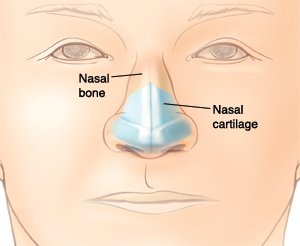A broken bone (fracture) of the nose may be a minor crack. Or it may be a major break, with the parts of your nose pushed out of place. A fractured nose causes pain, swelling, difficulty breathing through the nose, and nasal stuffiness. You may have bleeding from your nose. By tomorrow, you may have bruising around your eyes. Once the swelling goes down, you may notice a bump or some crookedness in your nose compared to before the injury.
Symptoms of more extensive injuries include double vision (diplopia), abnormal eye movements, vision loss, clear nasal discharge (rhinorrhea), and weakness and numbness in the face.
The diagnosis of a nasal fracture is usually made without X-rays. Plain film X-rays are not typically useful. But computed tomography (CT) scans may be done for other suspected head injuries.
A minor fracture will heal in 3 to 4 weeks, with no more treatment needed. A major break that changes the shape of your nose may need to be treated by an ear, nose, and throat health care provider (ENT or otolaryngologist). The ENT provider will straighten the bones in your nose. This is called a closed reduction.
Some fractures may need a reduction as soon as possible, such as when bleeding from the nose won't stop. Otherwise, it's best to wait a few days until the swelling has gone down. The health care provider will then be able to easily see any changes in your nose.
Home care
-
Sleep with your head elevated. Stay away from heavy lifting, strenuous exercise, and bending over with the head below the heart. This will help reduce swelling after the injury and after surgery.
-
Use an ice pack on your nose for no more than 15 to 20 minutes at a time. Do this every 1 to 2 hours for the first 24 to 48 hours. Then use the ice as needed to ease pain and swelling. To make an ice pack, put ice cubes in a plastic bag that seals at the top. Wrap the bag in a clean, thin towel or cloth. Never put ice or an ice pack directly on your skin.
-
Tell your health care provider if you are taking aspirin or blood-thinning medicine. These medicines make it more likely that your nose will bleed. Your provider may need to change your dose.
-
You may use over-the-counter pain medicine to control pain unless another medicine was prescribed. If you have chronic liver or kidney disease or a history of gastrointestinal ulcers, talk with your provider before using this medicine.
-
Don’t drink alcohol or hot liquids for the next 2 days. Alcohol and hot liquids can dilate blood vessels in your nose. This can cause bleeding.
-
Don’t blow your nose for the first 2 days. Then, do so gently so you don't cause bleeding.
-
Don’t play contact sports in the next 6 weeks unless you can protect your nose from getting injured again. You can wear a special custom-fitted plastic face mask to protect your nose.
-
Be aware that it might be uncomfortable to wear eyeglasses due to changes in the nasal shape.
-
Use saline sprays to prevent nosebleeds from happening again.
Special note on concussions
If you had any symptoms of a concussion today, don’t return to sports or any activity that could result in another head injury.
These are symptoms of a concussion:
-
Upset stomach (nausea).
-
Vomiting.
-
Dizziness.
-
Confusion.
-
Headache.
-
Memory loss.
-
Loss of consciousness.
Wait until all of your symptoms are gone and your health care provider says it’s OK to resume your activity. Having a second head injury before you fully recover from the first one can lead to serious brain injury.
Follow-up care
Follow up with your health care provider as advised. If your nose looks crooked after the swelling goes down, call the ENT provider for an appointment within the next 10 days. Also make an appointment if it’s still hard to breathe through 1 or both sides of your nose. If you have trouble getting an ENT appointment, call your regular provider.
If the bones are out of place, a reduction should be done 6 to 10 days after the injury. In children, the reduction should be done 3 to 7 days after the injury. After that time, the bones are more difficult to move back into place.
If you had X-rays taken, you will be told of any new findings that may affect your care.
When to call a doctor
Contact your health care provider right away if:
-
You keep bleeding from your nose, even after you've pinched your nostrils together for 15 minutes without stopping.
-
You have swelling, pain, or redness on your face that gets worse.
-
You have a fever of 100.4°F (38°C) or higher, as directed by your provider.
-
You have chills.
-
You can't breathe from both sides of your nose after swelling goes down.
-
You have sinus pain.
-
Clear fluid keeps draining from your nose.
Call 911
Call
-
You have repeated vomiting.
-
You have severe headache or dizziness.
-
Your headaches or dizziness get worse.
-
You become sensitive to light and noise.
-
You lose awareness of your surroundings.
-
You are abnormally drowsy, or are unable to wake up as normal.
-
You're confused or have a change in behavior or speech.
-
You have memory loss.
-
You have convulsions or seizures.


